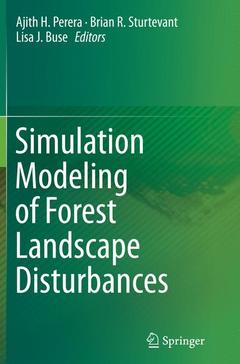Description
Simulation Modeling of Forest Landscape Disturbances, Softcover reprint of the original 1st ed. 2015
Language: English
Subjects for Simulation Modeling of Forest Landscape Disturbances:
105,49 €
Disponible chez l'éditeur (délai d'approvisionnement : 15 jours).
Add to cartPublication date: 10-2016
Support: Print on demand
Prix indicatif 105,49 €
Disponible chez l'éditeur (délai d'approvisionnement : 15 jours).
Add to cartPublication date: 08-2015
321 p. · 15.5x23.5 cm · Relié
Résumé
/li>Sommaire
/li>Biographie
/li>Commentaire
/li>
Forest landscape disturbances are a global phenomenon. Simulation models are an important tool in understanding these broad scale processes and exploring their effects on forest ecosystems. This book contains a collection of insights from a group of ecologists who address a variety of processes: physical disturbances such as drought, wind, and fire; biological disturbances such as defoliating insects and bark beetles; anthropogenic influences; interactions among disturbances; effects of climate change on disturbances; and the recovery of forest landscapes from disturbances?all from a simulation modeling perspective. These discussions and examples offer a broad synopsis of the state of this rapidly evolving subject.
1. Simulation modeling of forest landscape disturbances: An overview
Ajith H. Perera, Brian R. Sturtevant, and Lisa J. Buse
2. Modeling windthrow at stand and landscape scales
Stephen J. Mitchell and Jean-Claude Ruel
3. Approaches to modeling landscape-scale drought-induced forest mortality
Eric J. Gustafson and Douglas J. Shinneman
4. Modeling wildfire regimes in forest landscapes: Abstracting a complex reality
Donald McKenzie and Ajith H. Perera
5. Modeling insect disturbance across forested landscapes: Insights from the spruce budworm
Brian R. Sturtevant, Barry J. Cooke, Daniel D. Kneeshaw, and David A. MacLean
6. Individual-based modeling: Mountain pine beetle seasonal biology in response to climate
Jacques Régnière, Barbara J. Bentz, Jim A. Powell, and Rémi St-Amant
7. Southern pine beetle herbivory in the southern United States: Moving from external disturbance to internal process
Andrew G. Birt and Robert N. Coulson
8. Exploring interactions among multiple disturbance agents in forest landscapes: Simulating effects of fire, beetles, and disease under climate change
Robert E. Keane, Rachel Loehman, Jason Clark, Erica A.H. Smithwick, andCarol A. Miller
9. Simulating forest landscape disturbances as coupled human and natural systems
Michael C. Wimberly, Terry L. Sohl, Zhihua Liu, and Aashis Lamsal
10. Simulating forest recovery following disturbances: Vegetation dynamics and biogeochemistry
Robert M. Scheller and Mark E. Swanson
11. Simulation modeling of forest landscape disturbances: Where do we go from here?
Ajith H. Perera, Brian R.
Sturtevant,and Lisa J. BuseAjith H. Perera
Ontario Forest Research Institute
Ontario Ministry of Natural Resources
1235 Queen St. E., Sault Ste. Marie, ON P6A 2E5 Canada
ajith.perera@ontario.ca
Brian R. Sturtevant
Institute for Applied Ecosystem Studies, Northern Research Station, USDA Forest Service,
5985 Hwy K, Rhinelander, WI 54501 USA
bsturtevant@fs.fed.us
Lisa J. Buse
Ontario Forest Research Institute,
Ontario Ministry of Natural Resources,
1235 Queen St. E., Sault Ste. Marie, ON P6A 2E5 Canada
lisa.buse@ontario.ca
Synthesizes the current state of knowledge in forest landscape disturbance models
Uses models to explore advancements and challenges in modeling techniques
Identifies future needs in quantifying forest landscape disturbances
Includes supplementary material: sn.pub/extras




